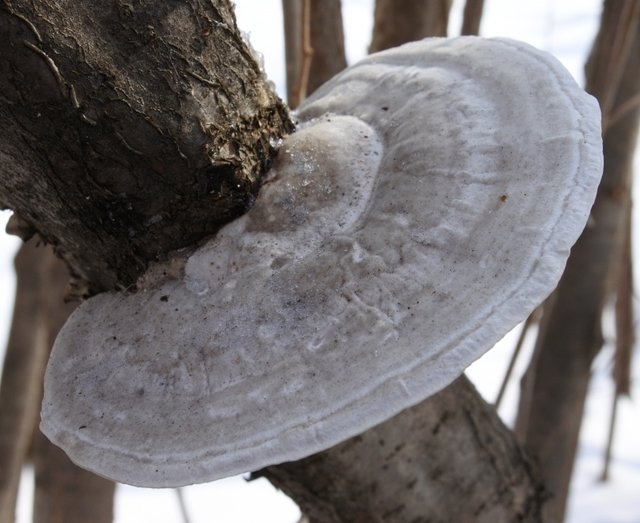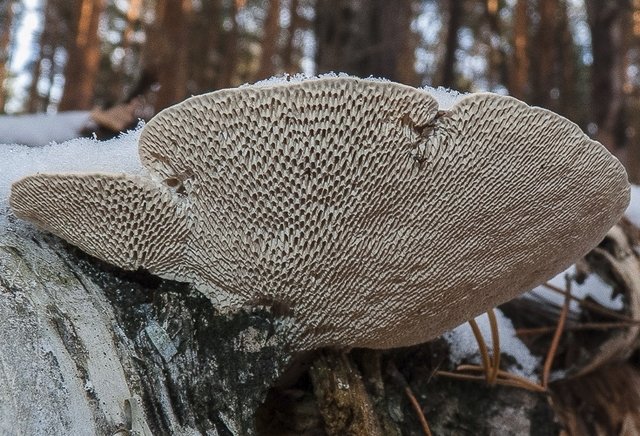Humpbacked trametes (Trametes gibbosa)
- Division: Basidiomycota (Basidiomycetes)
- Subdivision: Agaricomycotina (Agaricomycetes)
- Class: Agaricomycetes (Agaricomycetes)
- Subclass: Incertae sedis (of uncertain position)
- Order: Polyporales (Polypore)
- Family: Polyporaceae (Polyporaceae)
- Genus: Trametes (Trametes)
- Type: Trametes gibbosa (Humpbacked trametes)
:
- Trutovyk hunchback
- Merulius gibbosus
- Daedalea gibbosa
- Daedalea virescens
- Polyporus gibbosus
- Lenzites gibbosa
- Pseudotrametes gibbosa

Fruiting bodies are annual, in the form of sessile semicircular hats or rosettes 5-20 cm in diameter, arranged singly or in small groups. The thickness of the caps varies on average from 1 to 6 cm. The caps are more or less flat, with a hump at the base. The surface is white, often with separate darker concentric stripes of brownish, ocher or olive shades (alternatively white with a pinkish-brown edge), slightly hairy. The edge of the cap in young specimens is rounded. With age, the pubescence is lost, the cap becomes smooth, creamy-buffy and overgrown (to a greater extent in the central part, although it can be almost over the entire surface) with epiphytic algae. The edge of the cap becomes sharper.
The fabric is dense, leathery or cork, whitish, sometimes yellowish or grayish, up to 3 cm thick at the base of the cap. Smell and taste are inexpressive.
The hymenophore is tubular. Tubules are white, sometimes light gray or yellowish, 3-15 mm deep, ending in white or cream-colored radially elongated angular slit-like pores 1,5-5 mm long, 1-2 pores per millimeter (in length). With age, the color of the pores becomes more ocher, the walls are partially destroyed, and the hymenophore becomes almost labyrinthine.

Spores are smooth, hyaline, non-amyloid, more or less cylindrical, 2-2.8 x 4-6 µm in size. The spore print is white.
The hyphal system is trimitic. Generative hyphae with non-thickened walls, septate, with buckles, branching, 2-9 µm in diameter. Skeletal hyphae with thickened walls, aseptic, unbranched, 3-9 µm in diameter. Connecting hyphae with thickened walls, branching and sinuous, 2-4 µm in diameter. Cystidia are absent. Basidia are club-shaped, four-spored, 14-22 x 3-7 microns.
The humpback tinder fungus grows on hardwoods (dead wood, fallen trees, stumps – but also on living trees). It prefers beech and hornbeam, but is also found on birch, alder and poplar. Causes white rot. Fruiting bodies appear in summer and grow until the end of autumn. They keep well through the winter and can be seen the following spring.
A fairly common view of the northern temperate zone, although it gravitates noticeably towards the southern regions.
The humpback tinder fungus differs from other representatives of the genus Trametes in its radially diverging slit-like, as if dotted, pores.
Some exception is graceful trametes (Тrametes elegans), the owner of pores of a similar shape, but in him they diverge fountain-like from several centers. In addition, graceful trametes has smaller and thinner fruiting bodies.
In Lenzites birch, the hymenophore is brownish or grayish-brownish, lamellar, the plates are thick, branching, with bridges, which can give the hymenophore the appearance of an elongated labyrinth.
The mushroom is not eaten because of its tough tissue.
Substances that have antiviral, anti-inflammatory and antitumor effects were found in the tinder fungus.
Photo: Alexander, Andrey.









